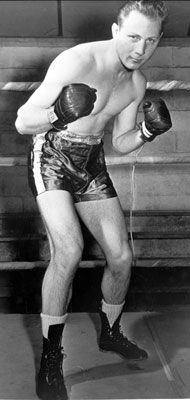Charley Fusari: The Irvington Milkman
By Dan Cuoco
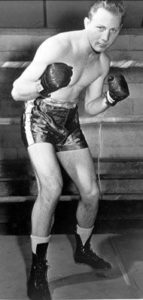 Charley Fusari was born Calogero Fusari in Alcamo, in the Province of Trapani, Sicily, on August 20, 1924, and emigrated to the United States in 1930. His first name, Calogero, being challenging to pronounce, was simplified to Charley.
Charley Fusari was born Calogero Fusari in Alcamo, in the Province of Trapani, Sicily, on August 20, 1924, and emigrated to the United States in 1930. His first name, Calogero, being challenging to pronounce, was simplified to Charley.
IBRO Director of Historical Research Tracy Callis wrote, “Fusari was a good fighter with a good punch; He lost but 12 of 78 bouts and scored 38 knockouts; Charlie won 45 bouts without a loss before tasting defeat. He defeated such men as Tippy Larkin, Attilio “Rocky” Castellani, Maxie Berger, Freddie Archer, Pat Demers, Al “Red” Priest, Terry Young, Joey Carkido, Jimmy Flood, Frankie Palermo, Vince Foster, Tony Pellone.”
Fusari fought out of Irvington, New Jersey, was managed by Vic Marsillo, and was trained by Tony Marsillo. Early in his career, he bought a milk delivery business for his family with his ring earnings and was known after that as “The Irvington Milkman.” Between November 1946 and March 1952, he was ranked as high as the number two welterweight contender in the world by Ring magazine. Charley had two world title shots during his career. He lost a one-sided decision to defending welterweight champion Sugar Ray Robinson on August 9, 1950, and a split decision to Johnny Bratton for the vacant National Boxing Association World welterweight title on March 14, 1951.
Charley was drawn to boxing after watching his older brother Tommy make a name for himself as a New Jersey Golden Gloves Champion and a professional active from 1939 to 1944. Despite suffering from impaired hearing, Charlie enjoyed enough success as an amateur to turn professional on May 8, 1944, at the age of 19.
Fusari Catches the Fancy of the Local Fight Crowds
His first professional fight was a victory over Jimmy Mills in Newark. His brother Tommy fought on the same card, also winning his bout. The Marsillo brothers brought Charley along slowly during his first six months as a pro fighting on undercards at Laurel Garden and Meadowbrook Bowl in Newark, New Jersey; Roosevelt Stadium in Union City, New Jersey; Jersey City Garden in Jersey City, New Jersey; and Madison Square Garden in New York. He finished his first year undefeated in ten fights, five by kayo.
In his eleventh professional fight on February 1, 1945, Fusari cemented his reputation as a fan favorite in his debut at Camden, New Jersey’s Convention Hall. His opponent was Philadelphia’s George Holden, a hard-punching muscular slugger whose main forte was to punch until he or his opponent hit the deck for keeps, and in their first round it looked as though George would win by a knockout. He dropped Fusari three times, Charley taking counts of nine each time he went down, and it looked like another round would finish him. Although he was dropped three times, Fusari was only hurt once from a left hook to the stomach that floored him a second time, making him winch. Fusari never permitted Holden to get set when the second round opened. He tore into him and punched Holden groggy in a little more than two minutes, prompting referee Harry Coplin to stop the fight after Holden sprawled helplessly in his corner. (The ropes had held up Holden for at least a minute, Fusari hammering him with both hands until Holden finally dropped to the mat, unable to defend himself.) The Camden Courier Post reported, “It’s been many years since a kid fighter caught the fancy of a local fight crowd as Charley Fusari did last night. No young fighter ever received a bigger hand here than Fusari did when he left the ring.”
Fusari’s Unbeaten Record Reaches Forty-Five
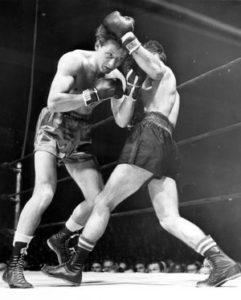
From February 8, 1945, until February 14, 1947, Fusari went undefeated in another thirty-four bouts, stretching his unbeaten record to forty-five, thirty by kayo. Along the way, he defeated Tommy Mills (KO 3), Pat Scanlon (KO 8), Pat Demers (KO 8), Joey Peralta twice (PTS 8, PTS 10), Jackie Leamus twice (PTS 10, PTS 8), Humberto Zalava (PTS 10), Maxie Berger (PTS 10), Johnny Lovatt (KO 8), Freddie Archer (TKO 6), Jackie Larrimore (KO 3), Chuck Taylor (TKO 6), and Tippy Larkin (TKO 9).
Fusari’s sixth-round stoppage of Newark, New Jersey’s Freddie Archer (84-12-4) before 12,000 fans at Ruppert Stadium, Union City, New Jersey, on August 22, 1946, ran his unbeaten record to forty-two. Charley easily defeated Archer, dropping him three times for counts of nine in the first round and again dropping him for nine in the sixth. The victory moved him into Ring magazine’s world welterweight ratings for the first time at number ten.
On October 31, 1946, Fusari traveled to Fall River, Massachusetts, and ran his winning streak to forty-three with a third-round knockout over Jack Larrimore (70-33-4). Charley extended his winning streak to forty-four on December 13, 1946, with an exciting sixth-round technical knockout over tough Coalport, Pennsylvania welterweight Chuck Taylor (22-5-2) before 12,008 roaring fans in the main event at Madison Square Garden. Taylor knocked Fusari down in the third round with a right to the jaw. Fusari, though, controlled the remainder of the bout, pummeling Taylor in the fourth, fifth, and sixth rounds. Taylor did not answer the bell for the seventh round due to a fractured rib.
On February 14, 1947, Fusari stopped number two-ranked welterweight contender Tippy Larkin (112-9-1) in the ninth round before a capacity crowd of 18,494 at Madison Square Garden. Charley, a 2-1 underdog, started the fight by throwing punches from all angles forcing Larkin to retreat. Midway through the first round, a long left hook dropped Larkin for a count of seven. On arising, Larkin stood toe to toe with Fusari in a hot exchange.
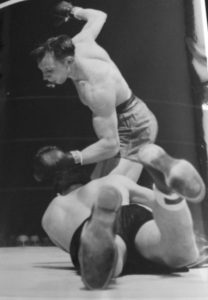
In the second round, Fusari continued to throw punches from everywhere and again dropped Larkin, this time from a long right to the temple. When Larkin regained his feet at the count of nine, he boxed cautiously for the remainder of the round. Larkin rallied in the third, fourth, and fifth rounds and boxed well at long range, repeatedly landing right hands at close quarters.
But Fusari turned the fight to his favor in the sixth round by pounding Larkin’s body with a steady two-handed attack. The body attack paid dividends because Larkin came out slowly to start the seventh round while Fusari continued to fire away with both hands. Near the close of the round, Fusari floored Larkin for a nine count with a left and right to the head. Larkin had enough left to out jab Fusari in the eighth, but in the ninth, Fusari maneuvered himself inside and dropped Larkin for a count of eight with a short left to the chin and then put him down again with a series of head punches forcing referee Arthur Donovan to stop the fight. Charley’s forty-fifth consecutive win elevated him to number two in the Ring world welterweight ratings.
Fusari’s First Loss Affects His Self Confidence
On June 13, 1947, Tony Pellone (30-9-5) ended Charley Fusari’s winning streak at forty-five by roughing and mauling his way to a ten-round split decision at Madison Square Garden. Pellone, a 2-1 underdog, came from behind after Fusari piled up a good lead to catch the eye of one judge and also referee Arthur Donovan, although the other judge voted for Fusari. It was a sizzling fight with 12,499 fans on their feet and roaring at the action. Fusari started off looking good through the first five rounds, nailing Pellone with rights and lefts to the head and giving his shorter opponent a thorough going-over. And then, in the sixth round, Fusari began to tire and became arm weary. All the sharpness had gone out of his punches, and Pellone started to score repeatedly with uppercuts and little flurries, bobbing up out of his weaving crouch to nail Fusari with rights and lefts. Pellone half-closed Charley’s left eye in the sixth round, and in the eighth, he opened a small slice over Fusari’s other eye. Charley countered this by bringing blood from Tony’s mouth and nose with a slashing right in the sixth round and opening a cut under Pellone’s left eye in the tenth. The loss dropped him to fifth in the Ring world welterweight ratings and propelled Pellone to number four.
Putting aside Fusari’s spectacular knockout of Tippy Larkin, the balance of 1947 did not turn out to be a stellar year for Charley. The loss to Pellone affected his self-confidence, resulting in a spotty record for the balance of the year. On July 18 Philadelphia’s Eddie Giosa (44-13-2), a 16-5 underdog, handed Fusari his second defeat by winning a razor-thin ten-round majority decision at Madison Square Garden. The fight was close, with both referee Arthur Donovan and judge Tom Guilfoyle scoring the fight even in rounds 5-5, while judge Frank Forbes scored it 5-4 in favor of Giosa. In supplemental scoring, Donovan scored it 12-12, and Guilfoyle scored it 10-9 for Giosa. Giosa’s victory over Fusari enabled him to gain seventh place in the Ring world welterweight ratings in place of Charley.
Fusari got back on the winning track with a fourth-round knockout over Joe DiMartino (27-9-3) at Madison Square Garden in New York on August 22; fought a ten-round draw with Johnny Cesario (57-3-1) in Boston on September 15; won a ten-round decision over Humberto Zavala (13-27-4) in Providence, Rhode Island, on October 8; lost a ten-round decision in a rematch with Johnny Cesario (57-3-2) in New Jersey on October 30; and finished the year with a ten-round decision over Sammy Adragna (36-15-2) in Pittsburgh on December 8, 1947.
A Return to World Title Contention
Charley Fusari returned to world welterweight title contention from 1948 to 1950. During that period, he compiled a record of 16-4-1 (KO 7/KO by 1).
In 1948, Fusari stopped Canada’s Gus Mell (41-10-4) in the fourth round in Boston; lost a close ten-round split decision to Al (Red) Priest (35-5-1) of Cambridge, Massachusetts, in Boston; reversed the tables on Al (Red) Priest in a Boston rematch by winning a lop-sided ten-round unanimous decision; won an eight-round decision over England’s Laurie Buxton (35-31-3) in New Jersey; won a ten-round decision over Ruby Kessler (37-12-2) in New Jersey; won a fourth-round knockout over Johnny Dudley (35-24-5) in Boston; won an eight-round technical knockout over Tony Riccio (49-32-11) in New Jersey; and won a six-round technical knockout over previous victim Tippy Larkin (123-11-1) in New Jersey. The victory over Lakin put Charley back in the Ring top ten at number five.
1949 didn’t start with great promise for Fusari to get a title shot at world welterweight champion Sugar Ray Robinson. On January 6, 1949, Charley had to rally to win a ten-round decision over the Bronx’s Frankie Palermo (29-8-2) at the Mosque Theatre in Newark, New Jersey. Unfortunately, this showing, coupled with recent impressive victories within the division by Freddie Dawson, Frankie Fernandez, and Gene Burton, scrambled the Ring ratings, dropping Fusari from five to eight. However, Charley came back with a bang in his next fight when he scored an upset decision over 1948 Rookie of The Year Rocky Castellani (30-3-4).
Castellani was an 8-5 favorite entering their February 18, 1949, Madison Square Garden encounter with Fusari. Dropped for a three count in the first round, Fusari electrified the crowd of 10,194 fans with a rally that brought him a unanimous decision. Castellani caught Charley cold in the first round and dropped him for a three-count with a terrific right to the jaw. Castellani was wild in his eagerness to finish him, allowing Fusari enough time to recover and rally, and as the round ended, Charley was fighting back. The tide turned in the second round as Fusari took advantage of Castellani’s wide-open, free-swinging attack. He pressed close and battered Rocky’s body, and a right to the jaw sent Castellani back on his heels. Fusari punched Rocky all over the ring through the third, fourth, and fifth. In the sixth, seventh, and eighth rounds, Castellani swarmed all over Fusari. His attack was furious, and he missed often, but he was able to rock Fusari to his heels in each of these rounds. Fusari was back on the attack in the ninth and tenth and met every one of Rocky’s assaults with a spectacular counterattack.
The Ring moved him to number six in their ratings ending March 15, 1949, for his fine showing. On April 6, 1949, Fusari ran his winning streak to nine with a ten-round unanimous decision over New York’s Al Guido (48-29-14) at the Manhattan Center in New York. Charley could never hurt the iron-chinned Guido, who was never stopped in his ninety-nine-fight career.
Vince Foster
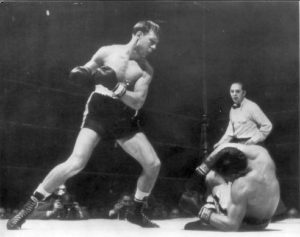
Next up for Charley was a meeting with the newest darling of the welterweight division, Vince Foster, scheduled for Madison Square Garden on May 13, 1949. Foster of Omaha, Nebraska, was a hard-punching welterweight of Native American heritage discovered by “Deacon” Jack Hurley. Foster crashed into the headlines a few months previously at Madison Square Garden when he handed tough Tony Pellone, who had snapped Charley’s 45 unbeaten winning streak, the first knockout defeat of his career. The 22-year-old Foster was so impressive that he was being hailed as the new “Golden Boy.” His record stood at 30-3-1, with 19 knockouts. Vince was being groomed for important outdoor matches during the summer. Beating Charley Fusari was to be part of the ambitious build-up. But Fusari busted the Foster bubble in less than one round before a Garden crowd of 14,193.
Foster came out fast at the opening bell and tried to overpower Fusari. Three vicious left hooks to the body made Charley wince. But Fusari fought back and stunned Foster with a right to the chin. Another right dropped Vince. Though hurt and dazed, Foster refused to stay down and take an eight count and stumbled up at two. Fusari ripped into him with both hands and dropped him with another right hand, this time for eight. Foster hardly reeled to his feet when he was dropped a third time for another eight. Fusari then waded in recklessly firing away with both hands from all angles. Crouching on the ropes, Foster did not catch any of these punches solidly, but he seemed unable to defend himself properly, and referee Ruby Goldstein stopped the action. Foster was plainly dazed as he was led to his corner. (Sadly, Vince Foster was killed in an automobile accident on July 18, 1949, a month before his 23rd birthday). Charley now established himself as a dangerous welterweight contender and saw his Ring world rating rise to number three, just behind Kid Gavilan, and Bernard Docusen.
Rocky Graziano
On July 7, 1949, Charley was paid expenses for engaging Canadian middleweight Al Evans (20-22-2) in a charity event for the John Beer Memorial Fund at Meadowbrook Bowl in Newark, New Jersey, and won an easy eight-round unanimous decision, running his record to an impressive 60-4-1, 36 by kayo. Shortly after the fight, Vic Marsillo, Charley Fusari’s manager, was eager to make a match with Rocky Graziano (49-8-5, 38 by kayo) because of his box office drawing power. Graziano had just returned to ring action after twelve months of inactivity after losing his world title to Tony Zale. Moreover, he did not look overly impressive in his two comeback fights, both second-round kayo wins against club fighters Bobby Claus (12-18-1) and Joey Agosta (31-25-5). Irving Cohen, one of Rocky Graziano’s managers, initially rejected a match with Charley because he felt Rocky’s weight edge would be too much. Cohen finally relented and agreed to match Rocky with Charley at the Polo Grounds in New York on September 14, 1949.
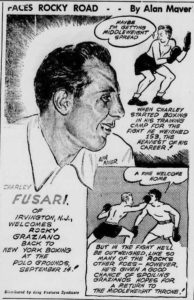 The argument for the 9 to 5 odds favoring the 27-year-old Graziano was he possessed a much harder punch and a twelve-pound weight advantage, 159 ½ pounds to 147 ½ pounds. When asked about the fight, Marsillo was optimistic. “Charley will win early by kayo.” The 25-year-old Fusari was also confident that he could beat Graziano. He said, “If Rocky wants it real tough, he will get it that way. I know this may sound corny, but it is true. Rocky tries to bull his opponents. I hope he tries the same thing with me. All I want is for him to come in on me. I’ll knock his brains out.”
The argument for the 9 to 5 odds favoring the 27-year-old Graziano was he possessed a much harder punch and a twelve-pound weight advantage, 159 ½ pounds to 147 ½ pounds. When asked about the fight, Marsillo was optimistic. “Charley will win early by kayo.” The 25-year-old Fusari was also confident that he could beat Graziano. He said, “If Rocky wants it real tough, he will get it that way. I know this may sound corny, but it is true. Rocky tries to bull his opponents. I hope he tries the same thing with me. All I want is for him to come in on me. I’ll knock his brains out.”
When queried by the press, Graziano commented, “This is one fight that will end in a knockout-and there’s nothing wrong with me that a kayo of Fusari won’t cure. I respect Fusari. He’s always in condition, and they tell me he’s a pretty good puncher. You’ve got to be careful every minute with a guy like that. He’s fast too, but I can still punch, and I’ll be in the best shape I ever was. This fight will not go to the limit. I’ll either knock him out or get knocked out trying, and I’ll be swinging from the opening bell.”
In the first round, Fusari surprised the crowd of 31,092 with his calm demeanor as he eagerly stepped forward, met Graziano head-on with left jabs and left-right combinations, and even staggered Rocky with a right hand while skillfully avoiding Rocky’s right hands. In the second round, Charley stepped lightly and confidently, moving inside Graziano’s punching and reaching Rocky with short, snappy blows. A succession of these opened a cut under Graziano’s left eye, which flowed intermittently for the remainder of the fight. It wasn’t until the third round that Graziano was able to land his right with any degree of effectiveness. He caught Charley with a couple of good right hands, but Charley shook them off and returned several lefts to the face on his own account. In the fourth, Graziano switched his attack to the body. His punches were hard and, in time, raised welts on Charley’s side, but Charley was in such excellent condition that few of the blows troubled him. The fifth was another good round for Graziano. He mixed his right-hand delivery to the head and body and absorbed only a few of Fusari’s straight left jabs.
The complexion of the fight turned in Fusari’s favor in the sixth and seventh rounds as he constantly landed left jab after left jab into Rocky’s face without let-up, making Rocky miss many of his ponderous right hands to the head. Graziano had a fine chance to show what power he had in his right hand in the eighth when he banged Charley’s jaw with it often. But, aside from buckling Fusari’s knees once, the blows did little damage, and Charlie, in time, resumed command of his boxing. The ninth was a splendid round for Fusari. Once more, his left jabs repeatedly made Graziano miss his right hand bombs, and he even held his own in the close exchanges with his heavier opponent.
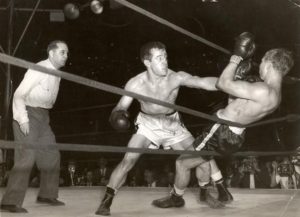
Then it happened – the explosive burst the crowd had been waiting for all evening. Graziano charged out of his corner for the tenth round, and early in the round, he dropped Charley with a series of rights and lefts to the jaw, and Fusari, after getting halfway to his feet at three, decided to kneel out the count of nine. When he arose, Graziano attacked him with a wild fury and pressed him to the ropes under a savage two-handed onslaught. The relentless Graziano pinned him in a corner, held his head in place with his left hand, and sledgehammered him with his right. With Fusari so obviously in danger, referee Ruby Goldstein had seen enough, pulled the snarling Graziano from his victim, and stopped the fight at 2:04 of the last round.
Immediately there came a howl from Fusari’s corner, his handlers jumping in the ring and berating Goldstein for stopping the fight. “He shouldn’t have stopped it,” stated Fusari. “I was waiting for him to slow up, and then I would have come after him.” But it was the general belief among the more objective fans that Goldstein was right, for Charley was decidedly shaky and unsteady on his feet when they posed for photographs. Charley admitted that the weight edge caught up with him in the last stages, and he was tired. The three officials all had Charley ahead after nine rounds. Judge Charley Shortell scored it 5-3 with one even. Judge Jack O’Sullivan recorded 5-4, while Goldstein’s card showed 4-3 with two even. The Associated Press had Fusari ahead 5-3 with one even. The loss dropped Charley to number five in the Ring world ratings.
Middleweight Struggles
On November 11, 1949, Charley stopped tough Terry Young (68-18-5) in the eighth round at Madison Square Garden before a crowd of 10,074. Fusari floored Young in the sixth round and twice in the eighth round, causing referee Eddie Joseph to stop the fight with Young spread out on the canvas. On December 27, 1949, the Ring annual ratings listed Fusari at number four behind Kid Gavilan, George Costner, and Bernard Docusen.
Nineteen-fifty started on a sour note for Fusari when he lost an upset ten-round decision to middleweight Tony Janiro (76-8-1) at the Olympia Stadium in Detroit on January 11, 1950. Charley was the 10-3 betting favorite but didn’t fight like it at any stage of the fight. He had a slight edge through the first four rounds, but then faded badly. Tony came on in whirlwind fashion in the late rounds to win the decision easily. The win elevated Janiro to number ten in Ring magazine’s world middleweight ratings and dropped Fusari to seven in their world welterweight ratings.
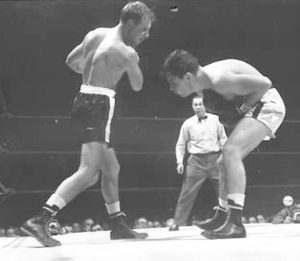
Fusari engaged in his third consecutive fight against a middleweight on March 10, 1950, but this time he came away with an impressive lop-sided ten-round unanimous decision over fast-rising Jimmy Flood (35-1-2) at Madison Square Garden. Fusari’s boxing ability and sharp punching were too much for Flood, who was engaging in his first main event at the Garden. Though Flood was reputed to be a strong puncher based on his impressive knockout string, Charley was never in danger of being knocked down, and the only knockdown to occur was by Fusari, who dropped Flood for a nine count in the third round. Thirty days later, Fusari won a ten-round unanimous decision over welterweight Joey Carkido (56-19-7) in Philadelphia. His victories over Flood and Carkido enhanced his Ring world welterweight rating to six.
On May 12, 1950, Charley was again paired with a middleweight. This time it was hard-punching middleweight contender Paddy Young (38-4-2). The two were involved in a torrid ten-round slugfest at Madison Square Garden, and when the officials totaled their scorecards, Young was declared the victor by the margin of a single point.
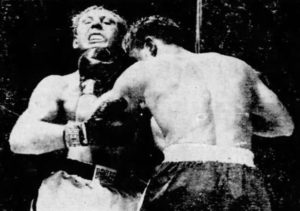
The first two rounds went to Young on his superior strength and willingness to wade in with his best punch, a left hook. Fusari rebounded with left jabs and left-right combinations and won the next two, and the fifth was even. Young won the sixth when he hooked and hurt Fusari in the opening minute. But Fusari gave Young a good pasting in the seventh, eighth, and ninth. He had Paddy’s eye streaming blood; he was catching him with nice one-two combinations and seemed in total control. Paddy then proceeded to change all that with a resounding final round. He came out in the tenth and sank a left hook in Fusari’s stomach. Charley jabbed furiously, but Young had his swinging left hook in a groove. He kept moving in with it, brushing aside Fusari’s countertactics with brute strength. He staggered Fusari with another left hook, then reopened a cut he had gashed earlier in the fight. Judge Joe Agnello scored it for Young six rounds to four, while referee Ruby Goldstein scored it for Fusari six rounds to three with one even. It was the card of judge Bill Healy that settled the affair. He scored the fight five to five, but his points favored Young, seven to six. Gene Ward of the Daily News reported, “I couldn’t find fault with the decision even though I had Fusari winning five rounds to four with one even. It was that close, and at least two of those rounds could have gone either way.”
Two World Title Shots
On May 20, 1950, the New York State Athletic Commission approved a welterweight elimination tournament to establish a challenger for Champion Ray Robinson. Kid Gavilan, Charley Fusari, Bernard Docusen, Billy Graham, and Lester Felton were the five fighters designated to meet in the eliminations. The tournament never came to fruition, but promoter Andy Niederreiter jumped at the chance to promote a championship featuring Charley Fusari as the most worthy challenger of the top three. He reasoned that Robinson had already beaten Gavilan and Doucsen, whereas the next available challenger, Fusari, who had been meeting middleweights, was unbeaten as a welterweight. On June 27, 1950, Niederreiter announced that Robinson had signed to defend his world welterweight title against Fusari in Jersey City’s Roosevelt Stadium on August 9, 1950. Niederreiter further stated that the Damon Runyon Cancer Fund would share in the receipts, adding that Robinson would only receive $1.00 for his services. At the signing, Fusari’s manager Vic Marsillo said, “I waited three years before I took this match. I turned it down several times because Charley wasn’t ready. But my kid is ready now, and Robinson can’t make 147 pounds and be strong, so we got a chance to lick him. If the champ doesn’t knock Charley out in four or five rounds, he’s liable to run into plenty of trouble.”
Sugar Ray Robinson vs Charley Fusari
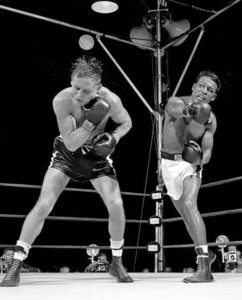
On August 9, 1950, Sugar Ray Robinson (110-1-2) won a lop-sided fifteen-round decision over Charley Fusari before a crowd of 30,000 at Roosevelt Stadium, Jersey City, New Jersey. Robinson was so weakened by pairing down to the 147-pound limit that he appeared a shadow of himself. His punches lacked explosiveness; he missed almost as many punches as he landed and lacked his usual eagerness to finish a hurt opponent. Referee Paul Cavalier only gave Fusari one round and called one even. It was a dull fight in which the lethargic Robinson forced the cautious Fusari about the ring in nearly every round. Sugar Ray gashed Charley’s left brow in the second round and brought blood from his nose in the eighth. He staggered Fusari in the ninth and fourteenth rounds but lacked the energy to finish him. Robinson appeared so tired in the seventh round some wondered if he would last the distance. In the twelfth, Fusari, urged on by his handlers to take a gamble, staged a rally that staggered Sugar Ray with a left to the jaw and several blows to the body. But Sugar Ray accepted the challenge, and for the first time in the fight, the spectators were treated to some real battling. The only other round Robinson found the going a little rough was the fourth when Fusari tested Sugar Ray’s strength. Despite his fatigue, Robinson had plenty in reserve in the last two rounds, and he made some attempts to end the fight by knockout. After the fight, Commissioner Abe J. Greene of the National Boxing Association (NBA) said, “In the event Robinson gives up his 147-pound title and gets the 160-pound shot, Fusari would fight the best opponent available for the vacant welterweight championship.” Greene explained, “Fusari proved by going fifteen rounds with Robinson that he was the number one welterweight contender.”
Johnny Bratton vs Charley Fusari
Charley Fusari returned to action on October 18, 1950, against his arch-rival Tony Pellone (47-17-6) at Chicago Stadium in Chicago. Tony gave Charley a rough time for five rounds but weakened steadily as Fusari wore him down, hurt him badly in the ninth round, and stopped him at 1:44 of the tenth round. Tony was helpless from the start of the final round, and the crowd shouted for the referee to stop the fight before Fusari dropped Pellone with a right to the jaw. Pellone regained his feet at the count of nine but was helpless, and referee Johnny Behr stopped the fight.
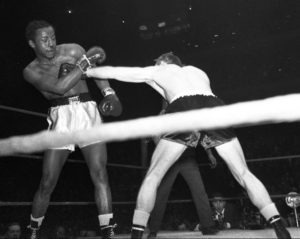
On February 14, 1951, Sugar Ray Robinson won the world middleweight title when he stopped Jake LaMotta in thirteen rounds. Two days later, the International Boxing Club (IBC) and the NBA announced they were making efforts to match welterweight contenders Charley Fusari and Johnny Bratton for March 14, 1951, to determine a successor to Sugar Ray.
Johnny Bratton (42-16-2) and Charley Fusari met for the NBA version of the vacant world welterweight title on March 14, 1951, at Chicago Stadium in Chicago. Bratton stood his ground long enough and punched just enough to win a fifteen-round split decision over Fusari, bringing a cascade of boos from the crowd of 6,954. The fans didn’t appreciate Bratton’s lackadaisical performance and applauded Fusari for his courageous effort. Fusari piled up most of his points for carrying the fight almost unceasingly to Bratton. Even when frequently staggered by Bratton’s sharp, cutting punches, Charley stood his ground, fought back, and seldom let up. Bratton dropped Fusari in the fourth round with a right to the jaw for a three count and almost knocked him out in the tenth round when Charley just managed to pull himself up before referee Tommy Gilmore reached the ten count. This knockdown was the peak of Bratton’s performance. He showed little inclination to fight in the last five rounds, except in the fifteenth when he had to fight back to contain Fusari’s desperate closing rally. Referee Tommy Gilmore scored 78-72 for Bratton; Judge Ed Hintz scored 77-73 for Bratton, and Judge John Bray scored 76-74 for Fusari.
The Final Four Fights
On June 7, 1951, Charley Fusari lost a close decision to middleweight contender Tony Janiro (80-11-2) at Rupert Stadium in Newark, New Jersey. The bout kept a crowd of 7,000 roaring through the late rounds as Fusari tried desperately to overcome the lead Janiro built up during the middle rounds. Fusari generally forced the fighting, but Janiro blocked most of his punches and consistently countered with a left hook over Fusari’s waiting right. Referee Paul Cavalier scored the bout five rounds for Janiro, three for Fusari and two even. The loss dropped Charley to number five in the Ring world welterweight ratings.
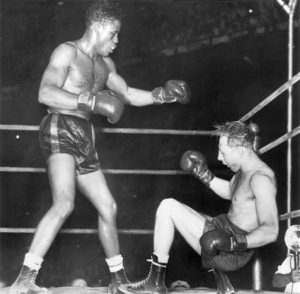
On July 9, 1951, boxing’s hottest prospect Gil Turner of Philadelphia (21-0-0), battered Fusari into bloody submission with a brutal two-fisted attack before 14,627 cheering fans at Shibe Park in Philadelphia. Turner never left the outcome in doubt, but it took him ten rounds and 58 seconds of the eleventh round of their scheduled twelve-rounder. Only Charley’s long experience against some of boxing’s finest enabled him to stay on his feet in the last two rounds. He called on every boxing instinct, but nothing could save him when Turner’s smashing left jab and overhand right connected in the eleventh. He went down for the full count, the first clean knockout loss of his career. His handlers helped him to his corner. Both of his eyes were closed, and his face was crimson. The win moved Turner to number five, while Charley dropped to number six in the Ring world welterweight ratings.
Charley stayed out of the ring for seven months, causing him to be dropped from the Ring ratings. He returned a shell of his former self on February 19, 1952, against club fighter Jimmy Champagne (10-15-2), winning an unimpressive eight-round decision at Laurel Garden in Newark, New Jersey, and losing an uninspiring eight-round decision to Champagne in a return match at the same venue on March 11, 1952. Immediately after the fight, Charley heeded his manager Vic Marsillo’s advice that he was through and officially retired at age 27, with an outstanding record of 65-12-1 (KO 38/KO by 2).
After his fighting days, Charley opened a bar across from City Hall in Newark, New Jersey. In the 1970s, he co-owned the Ocean 4 Restaurant and Cocktail Lounge in Asbury Park, New Jersey. He later worked as a liquor salesman until his death from cancer on November 1, 1985, at age 61. His wife Anne, mother Antoinette, sons Charley, Mark, and Robert, and brother Tommy survived him. Charley was inducted into the New Jersey Boxing Hall of Fame on October 17, 1976.
Primary Sources: Ring Magazine, New York Times, Brooklyn Daily Eagle, New York Daily News, Newark Star Ledger, Courier-Post, Boston Globe, Chicago Tribune, Philadelphia Enquirer, Detroit Free Press, and several online premium databases. I sincerely thank Tracy Callis and Roger Zotti for their insightful comments.
